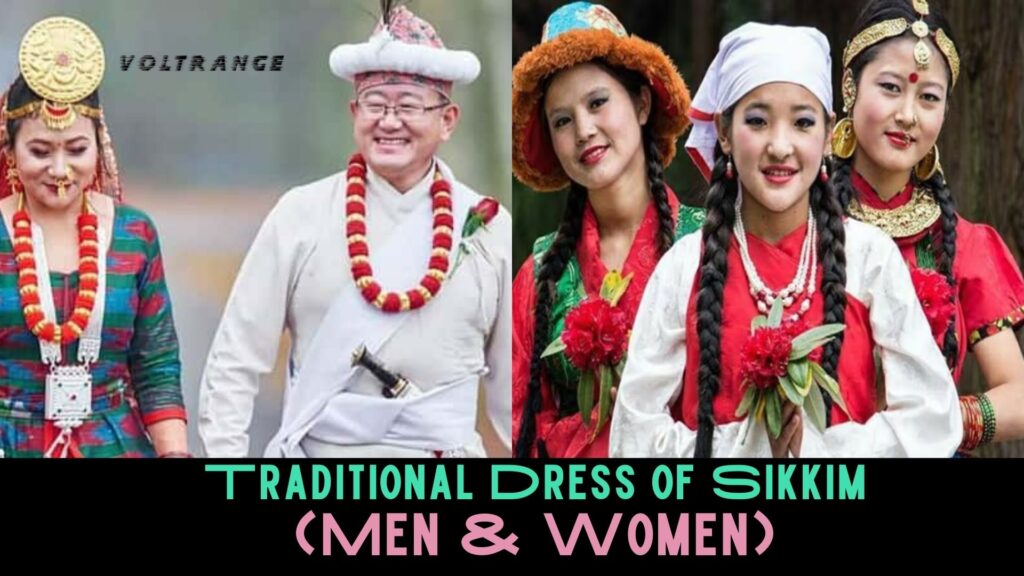
Traditional Dress of Sikkim
Sikkim, known for its serene rivers, breathtaking landscapes, vibrant dances, and delectable cuisine, also boasts a rich tradition of distinctive clothing that reflects the region’s diverse culture. The traditional dress of Sikkim is a captivating mix of colors, fabrics, and designs, each piece carrying deep cultural significance. In this article, we explore the stunning traditional attire worn by men and women in Sikkim, highlighting the unique styles across different tribes.
Tribal Attire in Sikkim
The traditional dress of Sikkim varies by tribe, with each group having its own unique style and customs. Let’s take a look at some of the most notable tribal outfits worn in the region.
1. Bhutia Tribal Dress
The Bhutia tribe’s traditional outfit is called the Bakhu, worn by both men and women. Resembling the Tibetan chuba, the Bakhu is a loose, wrap-around garment secured at the neck and waist with a silk or cotton belt. Women typically pair it with a long-sleeved silk blouse known as Honju, topped with a jacket called Kushen. In modern times, some women have added their own twist by pairing the Bakhu with jeans, reflecting a fusion of tradition and contemporary fashion.
2. Lepcha Tribal Dress
The Lepcha tribe’s attire is colorful and distinctive. Lepcha men wear a striped waistcoat known as Dumpraa, fastened on one shoulder and secured with a belt called Gyatomu. They pair it with ankle-length trousers and a white shirt, completing the look with a traditional cap, Sumok Thyaktuk. Lepcha women, on the other hand, wear an ankle-length dress called Dumden, accompanied by a loose blouse, Tago, and a waistband called Naamrek to keep the outfit fitted. Their attire is often complemented by a traditional cap, Gorey, adding elegance to their look.
3. Nepalese Tribal Dress
Nepalese make up nearly 80% of Sikkim’s population, and their traditional clothing is widely seen across the state. Nepalese men wear the Daura, a knee-length coat, paired with Suruwal, loose trousers. A waistcoat called Askot, along with the Dhaki Topi cap and Patauki belt, add a royal touch to the ensemble. For women, the traditional Pharia resembles a saree, usually in vibrant colors like red and yellow, paired with a long-sleeved blouse called Chaubandi Cholo. Some women opt for the Hembari, a large cloth draped from head to toe, adorned with beautiful floral prints. Accessories like the Majetro shawl and Pacheuri headgear add grace, while many men also carry the iconic Khukri in a leather case called Daab.
4. Thokro-Dum
A signature outfit of the Lepcha tribe is the Thokro-Dum, worn by men. It includes white pajama-like trousers that end at the calves, resembling martial arts attire. The trousers are paired with a Lepa shirt, an embroidered cap called Shambo, and a jacket known as Yenthatse. The short length of the trousers symbolizes the Lepcha’s origin in the marshy lands of Sikkim, where durability and practicality were essential for working in the fields.
Traditional Wedding Attire of Sikkim
Weddings in Sikkim are a grand affair, and the traditional wedding attire is no exception. The bride and groom typically wear the finest versions of the Bakhu, made from high-quality silk. The groom pairs his Bakhu with loose trousers, leather shoes, and a silk turban known as a Topi, while the bride wears an intricately designed Kho made of silk and brocade. The bride’s look is completed with a beautiful apron called Pangden and a headgear known as Pangkham, which is a large, multicolored scarf that covers her head. Together, the couple radiates elegance and royalty on their special day.
Traditional Jewelry of Sikkim
Jewelry plays an essential role in Sikkimese culture, with each tribe having its unique set of ornaments.
- Bhutia Jewelry: Bhutia women favor gold jewelry, including Joko (rings), Phiru (pearl ornaments), Yencho (earrings), Diu (gold bangles), Khalli (anklets), and Khao (thick anklets).
- Nepalese Jewelry: Nepalese women accessorize with pieces like the Sir-Bandi (a bejeweled tiara), Kantha and Naugeri (necklaces), and Charanihari (a traditional necklace). These stunning accessories add beauty to their vibrant attire.
- Lepcha Jewelry: The Lepcha women wear simple but elegant jewelry, such as the Lyak (necklace), Namchok (earrings), and Gyar (necklaces). Gold and silver are the primary materials used for these delicate ornaments.
Conclusion
The traditional attire of Sikkim is not just about clothing—it’s a reflection of the state’s rich cultural heritage and identity. Each tribe has its own unique garments and jewelry that are deeply rooted in history and tradition. From the majestic Bakhu and the vibrant Pharia to the intricate wedding outfits, every piece holds cultural significance. The traditional dresses of Sikkim are a beautiful window into the soul of its people, showcasing their pride, elegance, and diversity. Whether it’s the daily wear or the stunning wedding ensembles, these outfits capture the essence of Sikkim’s cultural richness, making them more than just attire—they are symbols of tradition and heritage.





More Stories
Is Derby an Indian Brand? Complete Guide
Uttar Pradesh’s Traditional Dress of Men & Women
Vofey Shop : The Ultimate Online Fashion Hub for Women